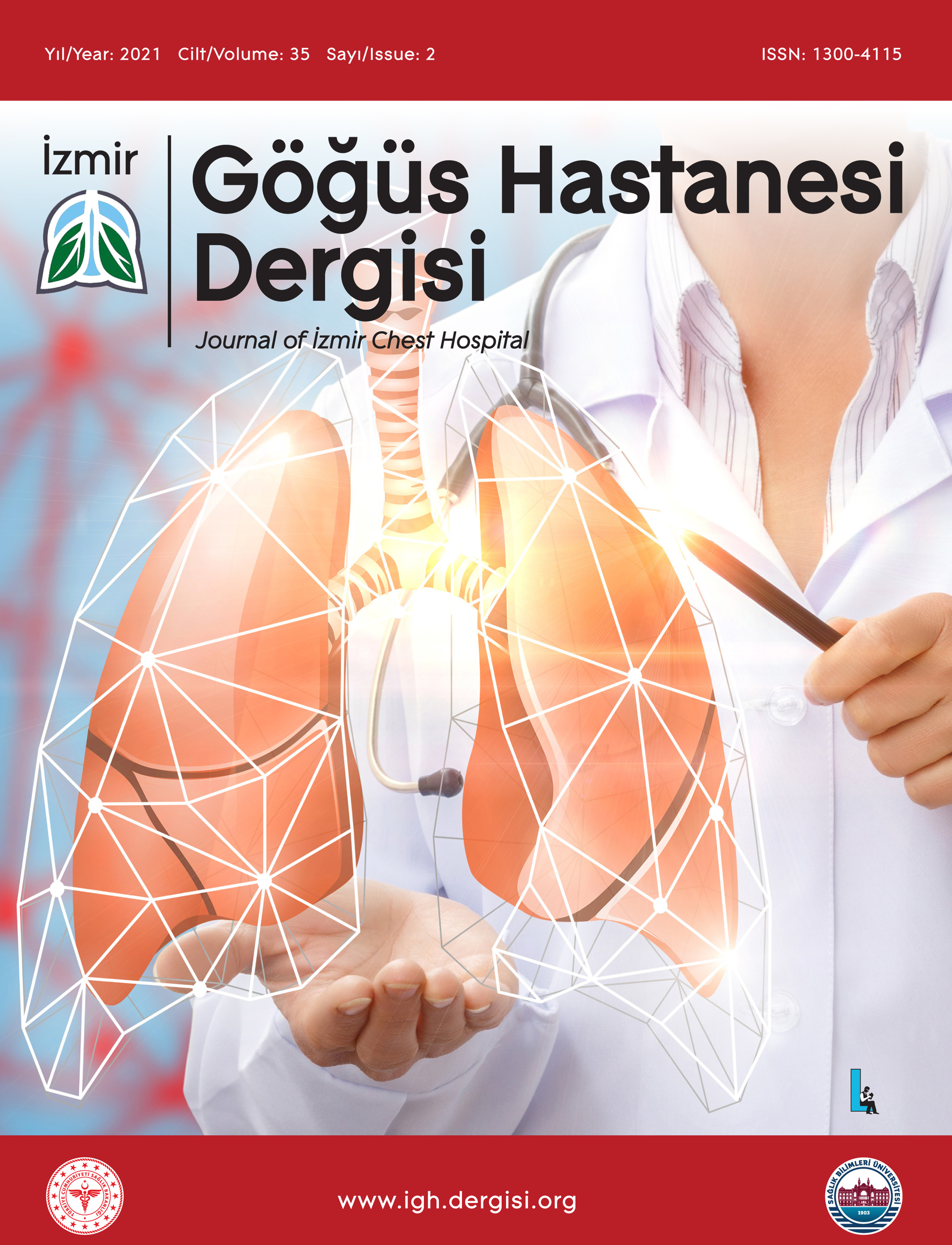Pandeminin Erken Döneminde Göğüs Hastalıkları Hastanesinin Covid Dışı Bir Servisinde COVID-19un Klinik Özellikleri ve Bulaşma Yolları
Mine Gayaf1, Ceyda Anar2, Filiz Güldaval1, Gülistan Karadeniz1, Gulru Polat1, Aysu Ayrancı3, Özgür Batum1, Dursun Tatar11Sağlık Bilimleri Üniversitesi Dr. Suat Seren Göğüs Hastalıkları ve Cerrahisi Eğitim Araştırma Hastanesi, Göğüs Hastalıkları Bölümü2İzmir Katip Çelebi Üniversitesi Atatürk Eğitim Araştırma Hastanesi, Göğüs Hastalıkları Bölümü
3İzmir Bakırçay Üniversitesi Çiğli Araştırma Hastanesi
GİRİŞ ve AMAÇ: Salgının erken evrelerinde Covid hastaları izole Kovid Servislerinde takibe alınırken, diğer akciğer hastalıklarının tetkiklerine COVİD olmayan servislerde devam edildi. COVID-19 ile diğer patojenlerin neden olduğu enfeksiyonlar arasındaki ayırıcı tanı yeterince tanınmamaktadır. Bu nedenle SARS-CoV2 veya başka bir patojen ile enfekte olan hastaları tespit etmek daha da zorlaşıyor.Bu çalışmada, Covid-19 vakalarının yaklaşık 2 ay içinde Covid-19 Dışı Servislerdeki klinik özellikleri ve bulaşma yolları incelendi. Pandeminin başlangıcından sonraki süre spekülatif olarak analiz edildi.
YÖNTEM ve GEREÇLER: Pandeminin erken dönemlerinde Göğüs Hastalıkları Hastanesinde Covid hastaları için karantina koğuşları oluşturulurken, Covid olmayan hastalarda ve yeni Covid dışı yatışlarda da değişiklikler oldu. 10.03.2020 ile 30.04.2020 tarihleri arasında Kovid Dışı Serviste bulunan Covid vakalarının klinik özellikleri ve bulaşma yolları geriye dönük ve gözlemsel olarak incelendi.
BULGULAR: Bu dönemde hasta, refakatçi ve sağlık çalışanı olmak üzere toplam 35 Covid vakası tespit edildi. Hastaların ortanca yaşı 50 (min-maks 25-85) idi. Ağır olmayan 17 hasta (%48,6), 18 ağır hasta (%51,4) ve 10 hasta öldü (%28,6). Toplam 25(%71,4) enfekte vaka SARS-CoV-2 Nükleik Asit Testi ile doğrulandı ve 11 (%28,6) olası COVID-19 vakası olarak klinik ve radyolojik olarak teşhis edildi. 65 yaş ve üzeri olmak, KOAH başta olmak üzere komorbid hastalığı olmak, semptom olarak nefes darlığının varlığı ve akciğer grafisinde tutulum sağkalım ile anlamlı olarak ilişkili bulundu (sırasıyla p0.027, 0.009, 0.038, 0.000 ve 0.033).Lenfopeni, nötrofil sayısı, CRP ve NLR değerindeki artış sağkalım ile istatistiksel olarak ilişkili bulundu (sırasıyla p 0,005, 0,001, 0,014 ve 0,000). 1'i refakatçi olmak üzere 4 süper yayıcı ve 3 hasta bulundu.
TARTIŞMA ve SONUÇ: Potansiyel süper yayıcılar, karantina koşulları uygulanmadan ve kapsamlı koruma uygulanmadan önce enfeksiyon kaynağı olabilir. Bu nedenle karantina, kişisel koruyucu ekipman kullanımı, sosyal mesafenin uygulanması ve dezenfeksiyon gibi kapsamlı önleyici tedbirlerin uygulanması hastane enfeksiyonunun kontrolünde çok önemlidir.
Clinical Characteristics and Transmission Routes of COVID-19 in the Early Period of the Pandemic in a Non-Covid Ward of Chest Diseases Hospital
Mine Gayaf1, Ceyda Anar2, Filiz Güldaval1, Gülistan Karadeniz1, Gulru Polat1, Aysu Ayrancı3, Özgür Batum1, Dursun Tatar11Health Sciences University İzmir Dr.SuatSeren Chest Diseases and Chest Surgery Training and Research Hospital2İzmir Katip Çelebi Üniversity, Atatürk Training and Research Hospital, Department of Chest Diseases
3İzmir Bakırçay University, Çiğli Training and Research Hospital,
Introduction and aim: In the early stages of the outbreak Covid patients were followed-up in isolated Covid Wards, and the examinations of other pulmonary diseases continued in Non-Covid wards. Differential diagnosis between COVID-19 and infections caused by other pathogens is not adequately recognized. For this reason, it is even more difficult to identify patients who are infected with SARS-CoV2 or other pathogens. In the present study, the clinical characteristics and transmission routes of the Covid-19 cases in Non-Covid Wards within approximately 2 months time after the onset of the pandemic were analyzed speculatively.
Materials and Method:
In the early periods of the pandemic, quarantine wards were created for Covid patients in Chest Diseases Hospital, but there were also changes in Non-Covid patients and new Non-Covid hospitalizations. The clinical characteristics and transmission routes of the Covid cases in Non-Covid Ward were examined retrospectively and observationally between 10.03.2020 and 30.04.2020.
Results: During this period, a total of 35 Covid cases were detected as a patient, companion and healthcare employees. The median age of the patients was 50 years (min-max 25-85). There were 17 patients (48.6%) who were not severe, and 18 severe patients (51.4%), and 10 (28.6%) patients died. A total of 25 (71,4%) of infected cases were verified with the SARS-CoV-2 Nucleic Acid Test, and 10 (28,6%) were diagnosed clinically and radiologically as possible COVID-19 cases. Being 65 years old or over, having comorbid diseases, especially COPD, the presence of dyspnea as a symptom and involvement on chest radiography were found to be significantly associated with survival (p0.027, 0.009, 0.038, 0.000 and 0.033, respectively). Lymphopenia, increase in neutrophil count, CRP and NLR value were found to be statistically related to survival (p 0.005, 0.001, 0.014 and 0.000, respectively). We found 4 super spreaders, one of whom was a companion, and 3 patients.
Conclusion: Potential super spreaders can be the source of infection before the quarantine conditions are applied and comprehensive protection is implemented. For this reason, quarantine, use of personal protective equipment, application of social distancing, and the implementation of comprehensive preventive measures, such as disinfection, are crucial in controlling nosocomial infection.
Makale Dili: İngilizce






